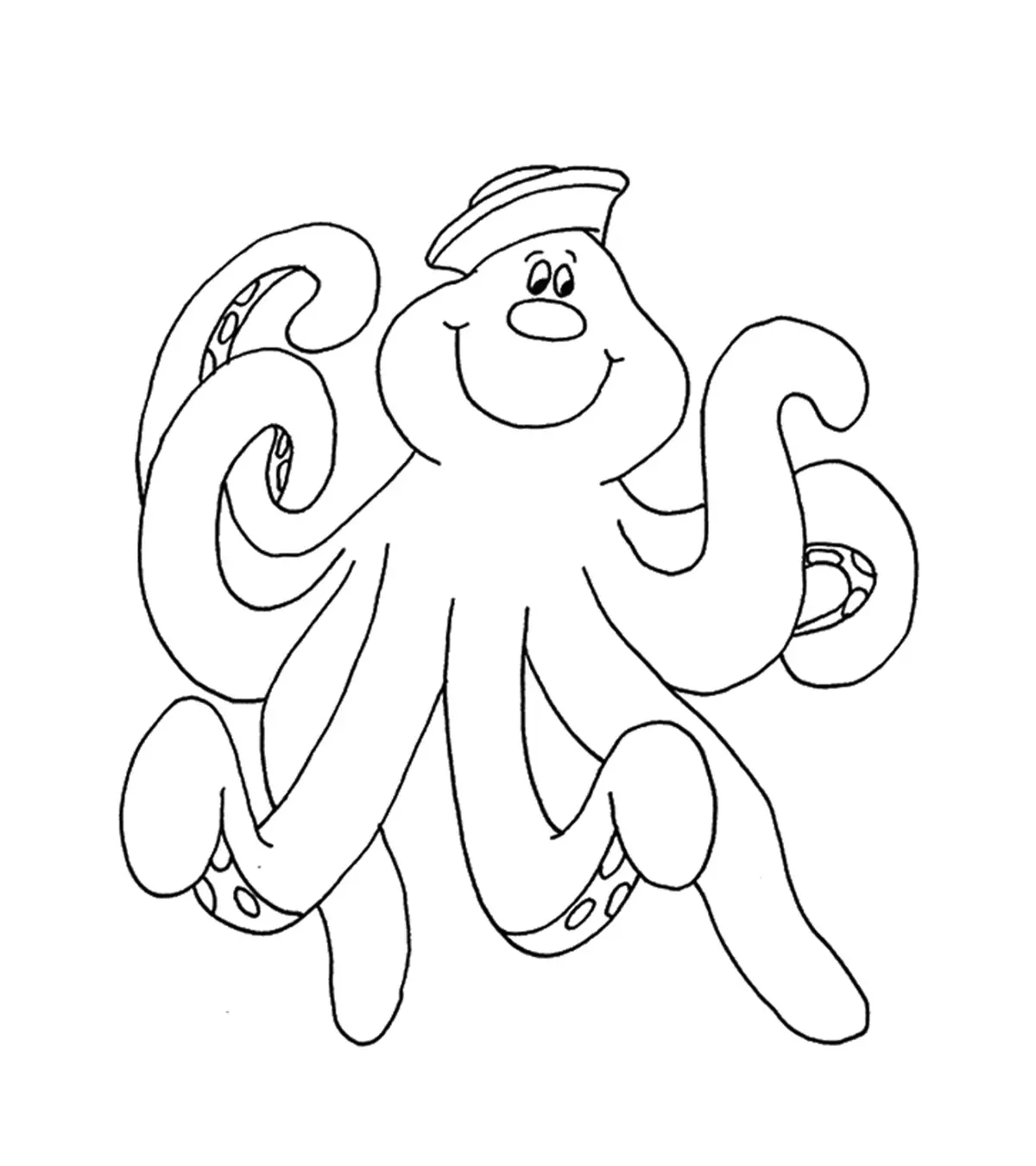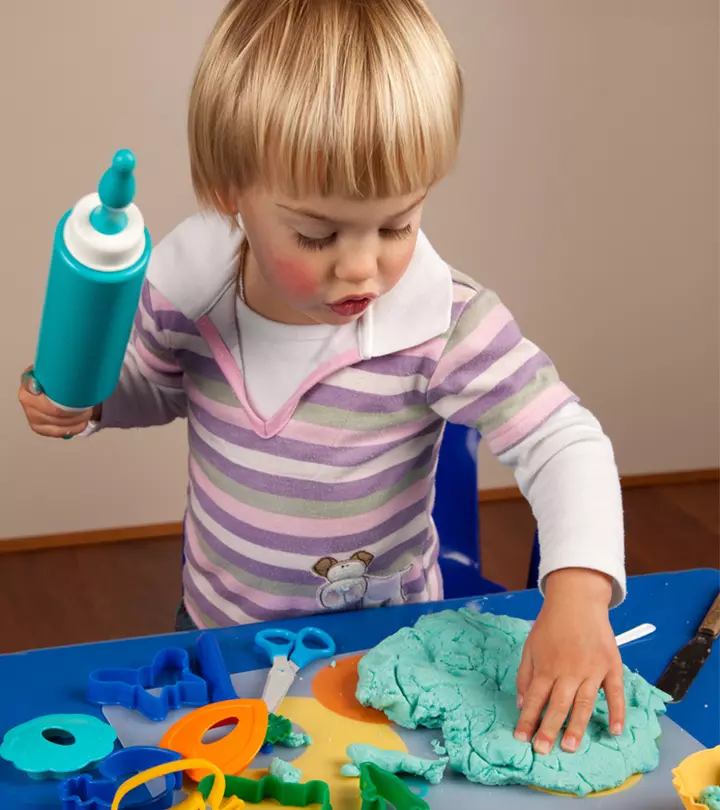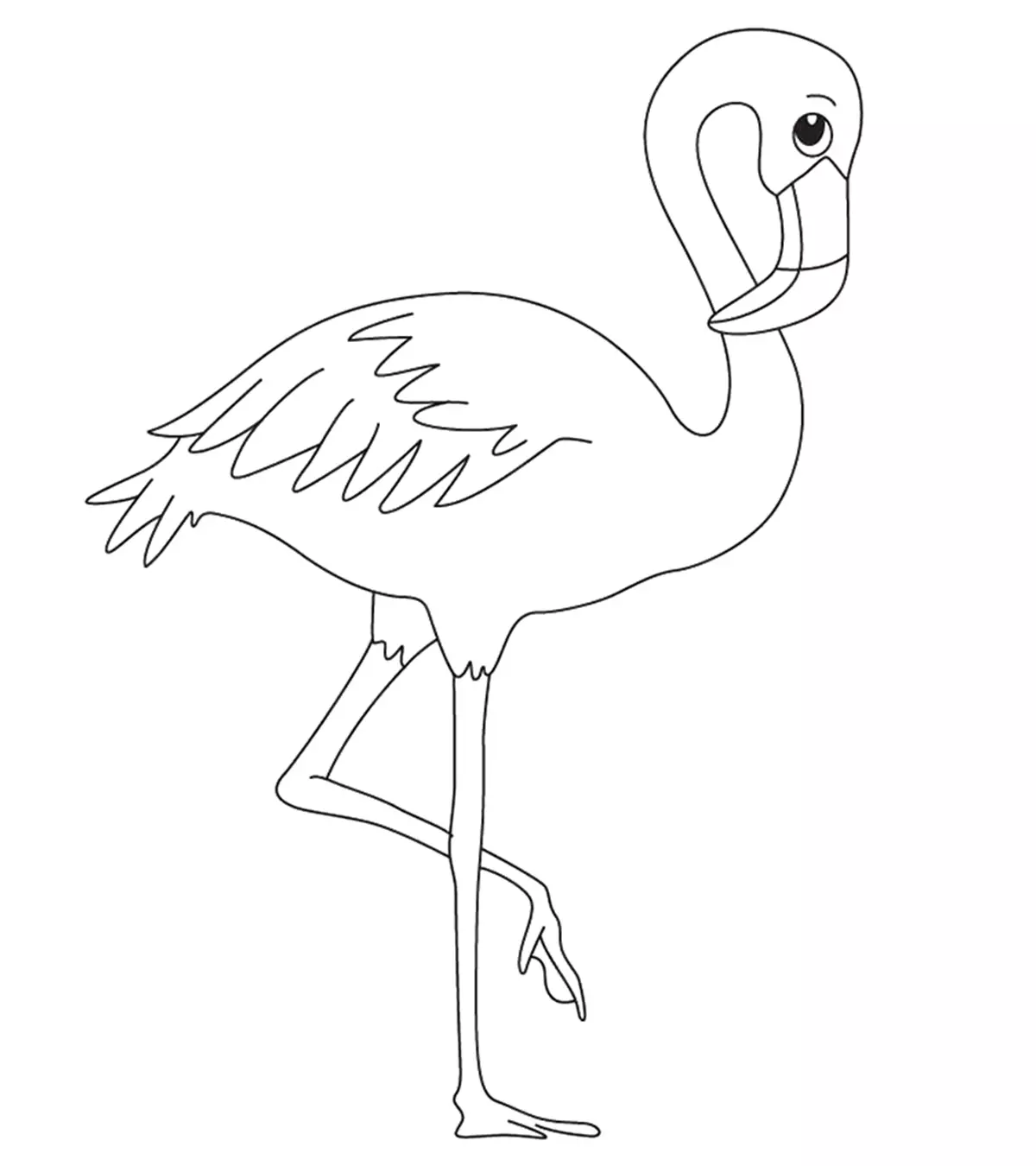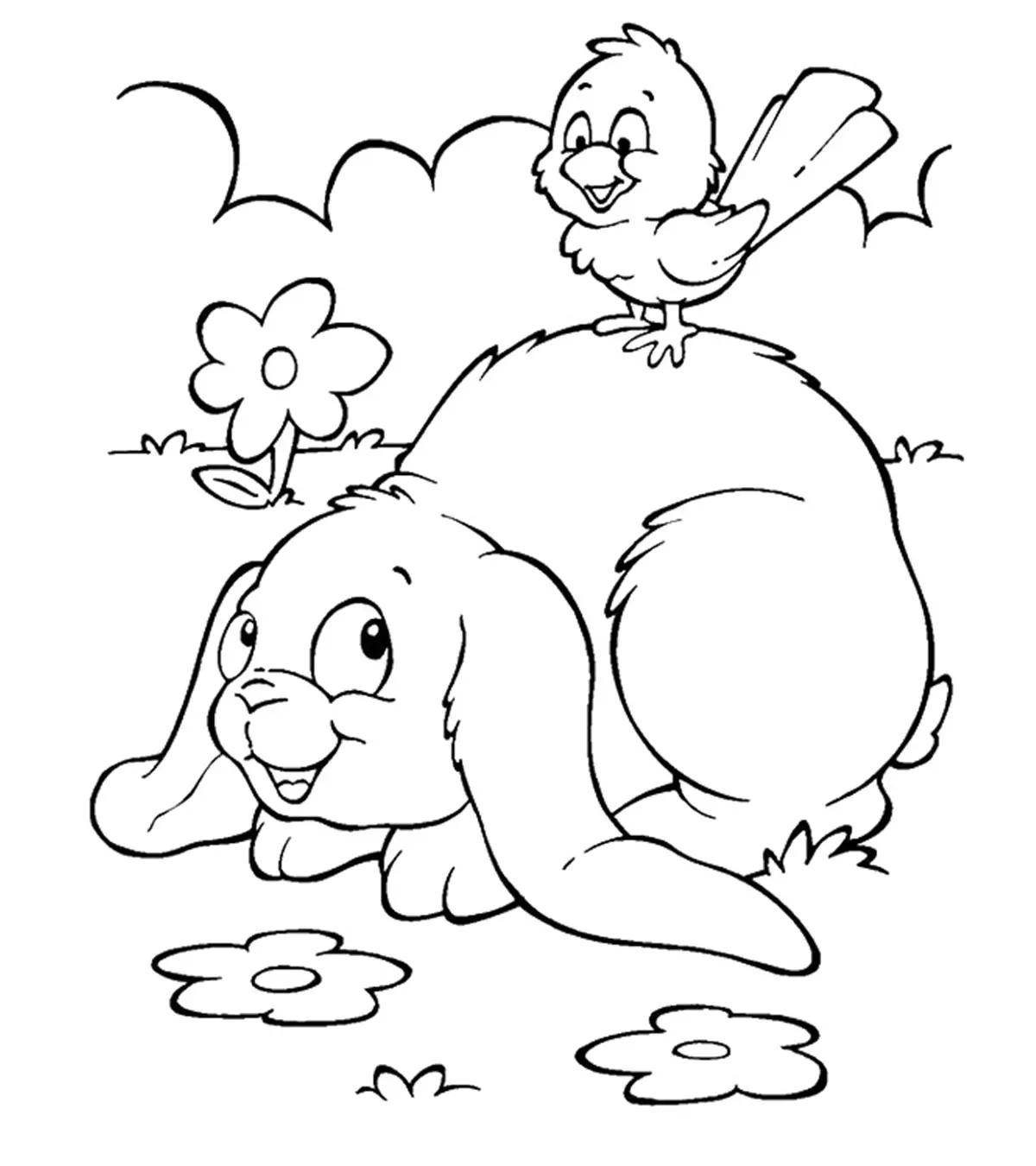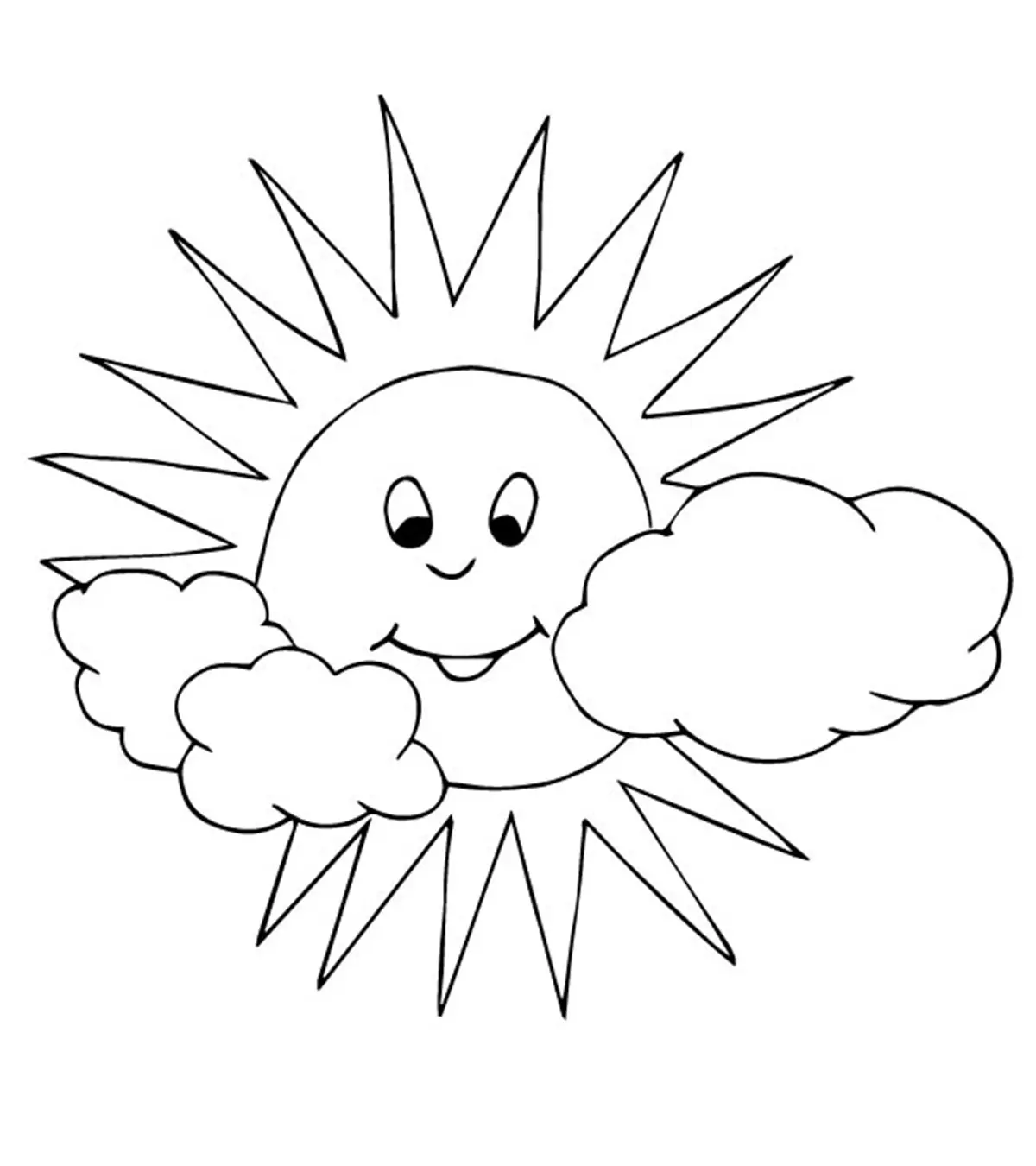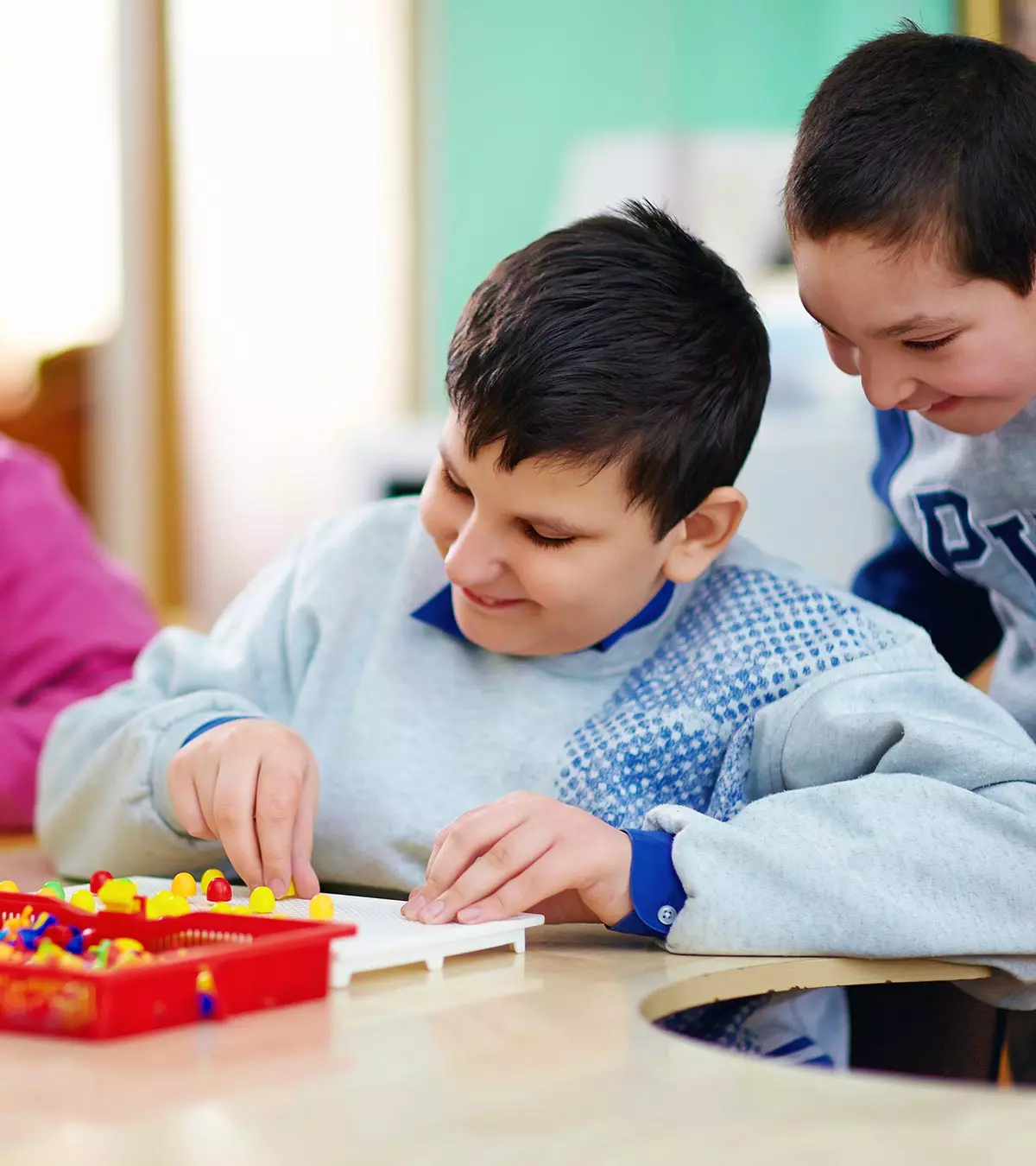
Image: Midjourney/ MomJunction Design Team
Engaging children in activities such as group games while incorporating playfulness is great for building social and emotional skills in kids. We present you with group games for kids in this post to help you entertain and engage them. When kids play together, they can learn to mingle with their peers and build interpersonal and communication skills. They also learn to expand their understanding of things and get accustomed to diversity. Plunge into this post for a list of the best educational group games that your children can play both indoors and outdoors.

Key Pointers
- Group games and activities for kids improve their cognitive, creative, and physical abilities.
- These games foster peer cooperation and help kids interact better with their teachers.
- Some games can be organized on any occasion to make the atmosphere livelier and more conducive to learning.
35 Fun Group Games And Activities For Kids
The games we have selected in this article aim to engage kids productively and aid in developing a child’s creative, intellectual, and kinesthetic abilities. We have categorized games into indoor activities and outdoor activities.
Indoor Group Games For Kids
The games are designed to make optimum use of the resources and space available indoors.
1. Fruit basket
Fruit basket is one of the best large group games to play indoors. It is fun and uses the basic materials that you are likely to find in every household.
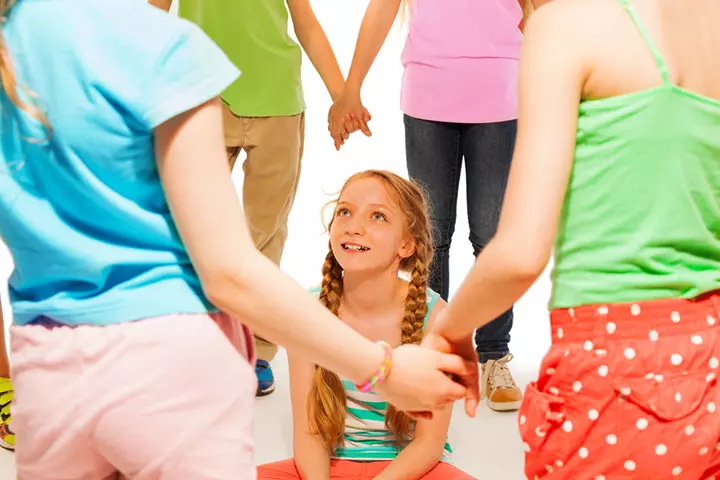
Number of players: 15 or more
You will need: Paper, double-sided sticky tape, and pens
How to play:
- Divide the children into four groups. Ask the groups to pick a theme such as dinosaurs, flowers, animals, fruits, scientists or anything else they like. You can also name the groups after some fruits, or just assign numbers.
- Give each player a sheet of paper and ask them to write the name of the team on one side and stick the tape to the other side.
- Mix all the groups and ask all but one to arrange themselves in a circle randomly. One person will stand in the center of the circle.
- The kids will have to stick their paper to the floor, like a floor marker, and stand on it.
- The player in the center of the circle will call out the name of a group. Each member of that group has to move to a new place in the circle, while the player in the center tries to steal a place in the circle.
- The child who remains out of the circle will stand in the center of the circle, and the fun continues!
This team-building activity for kids can be played around age three and above.
Infographic: Fun Indoor Group Games For Children
Some thing wrong with infographic shortcode. please verify shortcode syntaxA teacher and youtuber demonstrates the Fruit Basket game to his students on his YouTube channel A Slice of Pie. He recommends to his viewers that they can add a twist to the game by incorporating alphabet flash cards. “At home, you should always play with the vocabulary cards. Of course, you may need two or three copies of everything. So when somebody says a card like an elephant, elephant people have to move (i),” he says.
2. Steal the bacon
Steal the Bacon is a fun game that does not involve stealing bacon from the neighbor’s house or the host’s house. In fact, it has nothing to do with a piece of meat! Keep reading as we tell you what it is.

Number of players: 10-19
You will need: Objects that can be grabbed quickly, such as shoes, toys, balls, fruits, pens, etc., around 30 in number.
How to play:
- Divide the group into two equal teams. Have the two teams stand face-to-face in two parallel lines, with enough gap in between.
- Find as many objects as you can and place only one in the center.
- Assign a number (in sequence) to each member of a team, such that every member of one side has a counterpart with the same number in the opposing team.
- The moderator will call out a number at random (from the assigned numbers), and the kids with that assigned number should try to grab the object in the center.
- The team that gets the object gets a point, and the team with the highest score wins.
This game is ideal for middle school kids and pre-teens.
3. Cold wind blows
There is not a lot of physical activity in this game, but agility and presence of mind play an important role.

Number of players: 10-15
You will need: Space to play, chairs
How to play:
- Arrange the chairs in a circle. Have one chair lesser than the number of players.
- All players but one sit in the chair and one player stands in the center.
- The players will then say “a cold wind blows for anyone who…” and point at one of the sitting members.
For example, players can say:
“a cold wind blows for anyone who is wearing a black shirt.”
“a cold wind blows for anyone who has a mole on their hand.”
“a cold wind blows for anyone who plays basketball.”
And so on.
4. When the player says “a cold wind blows…”, anyone who meets the criteria should change their seat by choosing another player.
5. The player in the middle also tries to find a vacant seat while the players exchange places.
6. In the end, there is one player left.
This game can be fun for middle and high school students and can be played for as long as the group is having fun. You can also do away with the chairs and have the kids sit on the floor with markers.
4. Bob, the weasel
This is yet another circle game in which the objective is to find the hidden object. The game encourages kids to concentrate and try to read the other person’s body language.

Number of players: 8-15
You will need: A small object that can be passed around discreetly, space to play
How to play:
- Get the players to sit in a circle. One person is chosen to be ‘Bob, the weasel,’ who stands in the center of the circle.
- The players in the circle put their hands behind their back and pass the chosen object without giving Bob any hints about the exact position of the object.
- If Bob can point out who has the object successfully, the person caught with the object becomes Bob, and the game continues.
This game can be played by teenagers, tweens, and even adults.
5. The ah, um game
Fillers. Kids use them a lot, just as the adults do. Speakers may be okay using the fillers such as ‘ah,’ ‘um,’ ‘like,’ and ‘you know’ as many times as they want. But the listeners hate them. This indoor game for kids can teach them to speak without using the annoying fillers. Sounds interesting?

Number of players: 10-12
You will need: List of topics, timer
How to play:
- Divide the kids into teams of three or four.
- Give them the taboo words, a.k.a fillers such as ‘ah,’ ‘um,’ ‘like,’ ‘you know’ and so on.
- Next, give the kids a topic they can speak on for one minute. Topics could include favorite movies, meals, sports, holidays, authors, books, etc.
- Let a member of a group volunteer to speak about the given topic for one minute, without using the taboo words.
- If the child successfully avoids the taboo words, he or she moves to the next round. But if he fails, the next member gets the chance to speak.
The team that avoids using taboo words completely wins.
 Quick tip
Quick tip6. Walrus
This is a fun game that young kids and teens will enjoy all the same. The game is innovative, promotes inclusivity, and is sure to bring out a lot of laughs in the room.
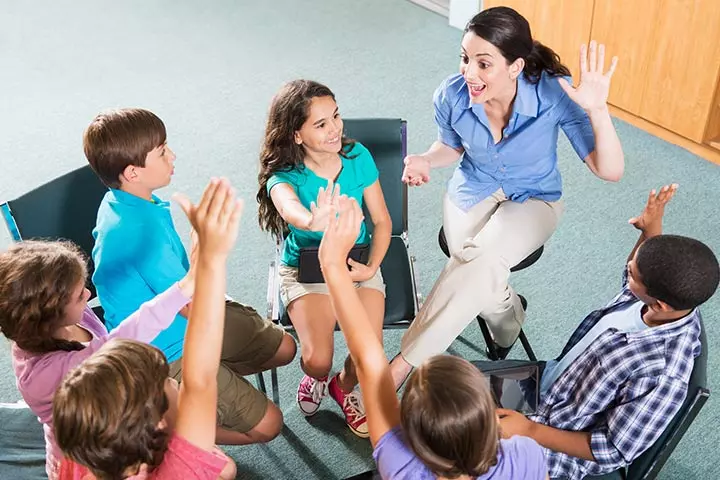
Number of players: 10-12
You will need: Chairs, closed room, and space to play
How to play:
Walrus is a guessing game wherein the players mask an activity or action with a word like ‘walrus,’ and one person has to guess what it is. The game encourages the kids to think and use language intelligently. The game also teaches kids to respond consciously, after careful thinking.
- One person is It and is sent out of the room.
- The others in the room decide upon one action or activity such as biking, eating, sleeping, dancing, reading and so on.
- Then they pick a random word like a walrus, teddy bear, peach, etc. that they will replace the word with.
- It comes back in and asks questions to guess what the word is, and the players in the room have to answer by replacing the word with the substitute word. For example, if the word is biking:
Q: When do you do this activity?
A: I walrus every day to school and whenever I feel like.
Q: Do you walrus at night?
A: Yes
Q: Do you walrus at home?
A: Yes
And so on. The kids answering the questions should be careful not to reveal the actual word.
7. Look up, look down
A fun game for all ages, Look Up, Look Down can be played on any occasion. Whether at a party, picnic or school, children will love playing this game.
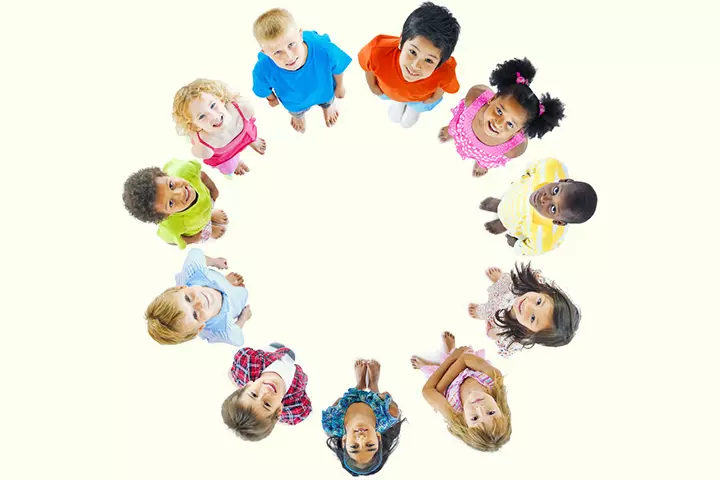
Number of players: 15-20
You will need: Place to form a large circle
How to play:
- Have the players form a large circle. They can stand a feet or two apart.
- Once the circle is formed, all the players should be asked to look down.
- When the moderator shouts out “Look up,” the players have to look up and immediately look at another person in the circle.
- If the person they are looking at them also looks at them at the same time, they scream together and leave the circle.
- The remaining players stand in their place and continue to stare at the person they have been looking at until the moderator says “look down.”
The game continues until there are no more than two to three players left in the circle.
8. Three things and a theater
This is a small group activity that encourages spur-of-the-moment creativity and helps in quick thinking. It also helps teach problem-solving to kids.

Number of players: 9-12
You will need: Props/everyday objects, space for performance
How to play:
- Pick three kids from the group and send them to the stage/performance area and ask them to present a skit that they can come up with in two-five minutes.
- The other participants can ask the three kids to use any object in the room as a prop in the skit.
- Give the children no more than two-three minutes each for the skit. Once they are done, pick another three members and repeat the steps.
Care should be taken to make sure that all the members of the group get a chance to perform. This game/activity is an excellent choice for summer camps and theater workshops.
9. Team architect
Team architect is one of the more common classroom games for kids. It helps children use their logical ability and common sense to create simple objects using the science of engineering and construction.
The game gives players basic materials, thus encouraging their problem-solving skills as well.

Number of players: 12-15
You will need: Basic craft material like glue, newspapers, string, pop sticks, sticky tape, etc., depending on the game you choose.
How to play:
- Divide the group into teams and give them the materials to build the selected object. Things you can ask to build are:
- A bridge or a book holder using popsicle sticks and glue
- A newspaper tower at least five feet tall
- An egg support
- Set a time limit and give specific instructions as to what the kids can do and cannot do to complete the task.
- The team that completes the project or task in time scores the point.
Make sure that the resources given to each team are the same. This activity is ideal for older kids and teenagers and works excellently in STEM classes at school.
10. Simon says
It is a classic game that can be played at once by a large group of children. It is fun and does not require any equipment.

Number of players: 3 or more
You will need: An unobstructed playing space
How to play:
- Choose one person to be ‘Simon.’
- This person will give commands, and others need to follow ‘its’ instructions.
- Have the players face the ‘Simon’ and make sure they can clearly hear the commands.
- ‘Simon’ will start the command with ‘Simon says…’ like ‘Simon says jump.’
- Do not follow the instructions if the command does not start with ‘Simon says.’
- If a player follows the command without ‘Simon says,’ they will be out of the game.
- The ‘Simon’ can act differently when giving commands to confuse the other players.
This game can be played by anyone older than eight years, as they are old enough to understand the instructions quickly and perform.
11. Freeze dance
Similar to the classic games ‘freeze tag’ and ‘Red light, Green light,’ this fun dancing game requires you to move without being caught, with an addition of music.
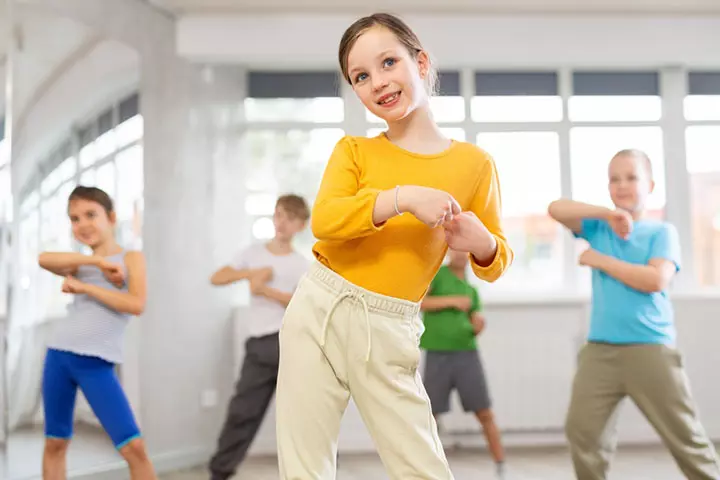
Number of players: 3 or more
You will need: Open space, music
How to play:
- Choose one player as a DJ who will control the music system.
- When the DJ starts playing music, all the players will start dancing.
- When the music stops, players must freeze in their dancing position. If the DJ notices someone moving, that player will get eliminated.
- When the DJ starts the music again, players will start dancing again until the music stops.
- You can continue the game as long as players are enjoying dancing or until each player gets eliminated.
You can also end the game if the DJ stops the music and announces the game to end.
12. Bingo
Bingo is a numbers game that can be played by children and adults. It is a game that involves concentration but is still fun.
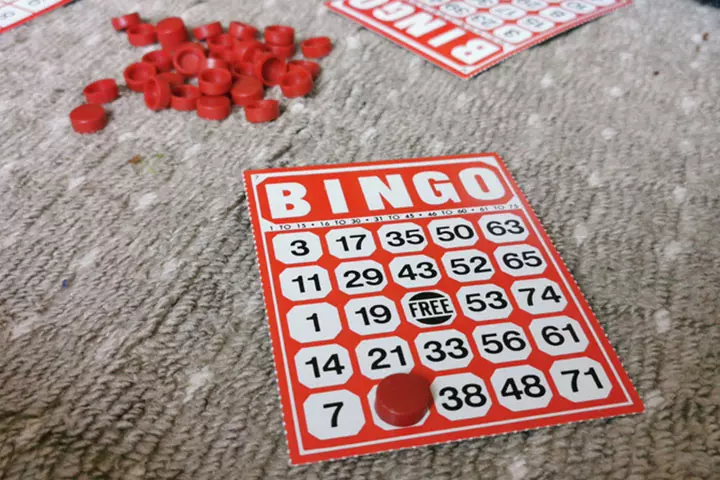
Number of players: 3 or more
You will need: Pencil or pen, paper or bingo cards
How to play:
- Give a bingo card of a 5*5 grid with 25 squares.
- Each square in the card will have random numbers ranging from 1 to 75.
- You can either purchase bingo cards or prepare them at home.
- Provide each player with a pen or pencil to mark the number on the card.
- Choose one person as the ‘caller’ who will draw and announce random numbers.
- When the caller announces a number, players check their bingo cards to see if they have it.
- If they have the number, ask them to cross it out using a pen or pencil.
- The goal is to complete a specific pattern of marked squares in the card, horizontal, vertical, diagonal row, or even a full house (all numbers crossed).
- The first person to complete the pattern and shout ‘Bingo’ wins.
Bingo is a game that requires attention since the caller may not repeat numbers. Therefore, make sure to be attentive and listen to the numbers carefully.
13. Deck of cards
There are many ways to play card games and accordingly, the instructions and numbers of players vary. The most popular card game for large groups is ‘Crazy eight’ where the player who discards all their cards first, wins the game.

Number of players: 5 to 8
You will need: Any type of playing cards
How to play:
- Choose one player as a dealer.
- Have the dealer shuffle the cards and distribute five cards to each player.
- Make sure the cards are face down when dealing.
- Set aside some cards for a central pile.
- Have players sit in a circle and take turns clockwise.
- Turn the top card of the deck face up.
- The first player will have to match the number, rank, or symbol with the deck card. If the player has such a card at hand, they can discard or they need to pull one card from the central pile.
- The first player to discard all their cards wins the round.
If all the cards in the central pile are used, you can reshuffle the dealt cards and place them face down to use as a central pile.
14. Monopoly
Monopoly is a classic board game that is popular among children as well as adults. You can either play this board game with your friends or family.
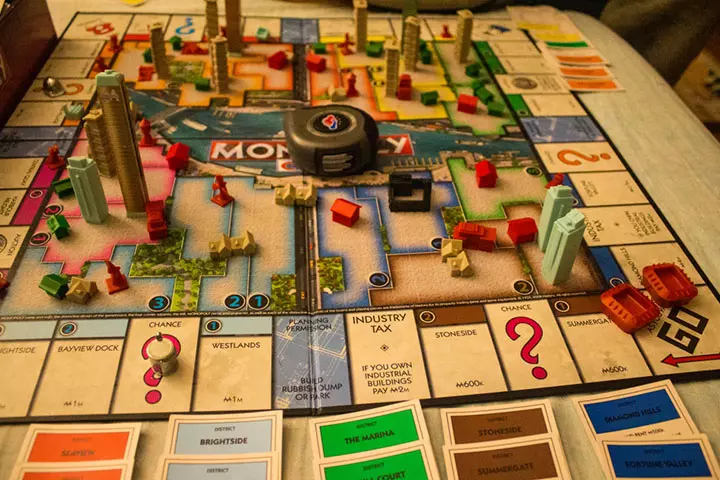
Number of players: 2 to 8
You will need: Monopoly Board
How to play:
- Place the Monopoly board in the center.
- Let each player choose a game piece to represent them on the board.
- The player who chooses to be a banker will shuffle the money and distribute $1500 to each player. The remaining money stays with the bank.
- Place the ‘Chance & Community Chest’ card decks face down on their designated spaces on the board.
- Shuffle the property deed cards and place them face down in stacks on the designated spaces on the board.
- Roll the dice to choose which player should go first and then play in a clockwise direction.
- The one who gets the highest roll will move their piece first.
- Move your game piece to the total number of spaces in the dice roll. Follow the instructions given in the space where your piece has landed.
- If you land on an unowned property, you can either buy it at the mentioned price or the bank will auction it off, and the highest bidder will get it.
- If you land on an owned property, railroads, utilities, income tax, or luxury tax, you must pay the rent or amount as per the mentioned price on the card.
- If you land on a ‘Chance & Community Chest,’ you will get to draw a card from their deck, and you need to follow the instructions on the card.
- Landing on ‘GO’ earns you $200 from the bank.
- If you land on ‘Go to jail,’ you must pay a fine. Alternatively, you may leave jail using the ‘Get Out of Jail Free’ card or rolling doubles on your subsequent turns.
- Players can go bankrupt by paying fines or owing more money than they can afford. During bankruptcy, banks auction all their assets and sell them to the highest bidder.
- The game continues until only one player owns all money and assets, and they are declared the winner.
15. I spy
I spy is a simple game that can be enjoyed by people of all ages. It helps with concentration, observation and vocabulary skills.
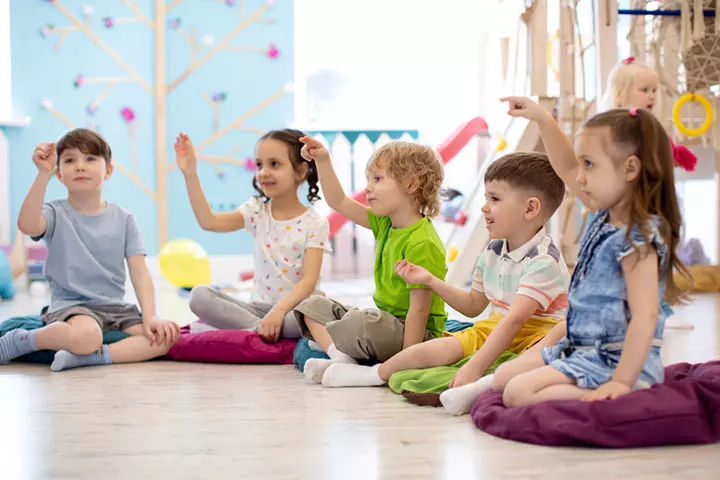
Number of players: 2 or more
You will need: Space and objects
How to play:
- Choose one person to be the spy.
- The spy will choose an object that they can see around.
- Once the object is chosen, the spy will say the phrase, ‘I spy with my little eye something…’ Instead of the object’s name, the spy can choose its color, material, function, size, or location.
- All the other players must guess the object based on the given clue.
- The players can ask ‘YES/NO’ questions for more clue.
- The first player who guesses the object correctly wins the round and becomes the next spy.
Make sure that the chosen object is visible to all the players. You may also use descriptive words and riddles to make the game more interesting.
16. Indoor bowling
Also known as lawn bowls indoors or short mat bowls, indoor bowling is a fun game for both children and adults. It can either be played in groups or individually.
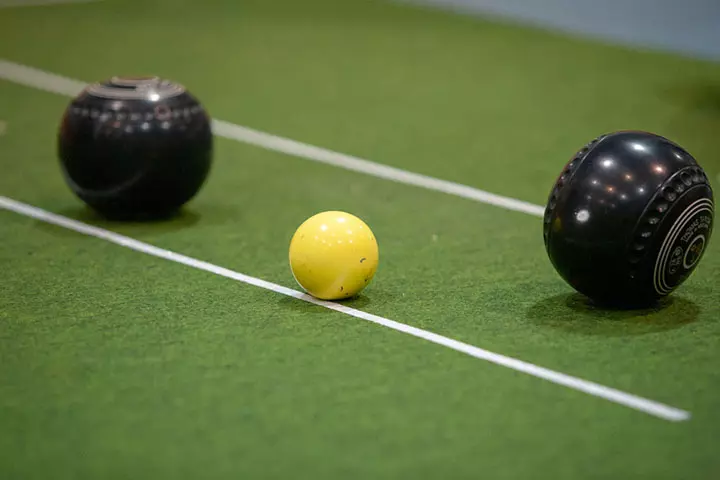
Number of players: 2 or more
You will need: Indoor bowling set or a medium-sized ball (jack), flat surface or mat, weighted bowls
How to play:
- Set the bowling area ready.
- Choose a player from each team to bowl.
- The player rolls the jack down the mat.
- Now, each player will take a turn to roll their individual bowl closest to the jack within the designated area or mat.
- The team with the highest number of bowls closest to the jack will score the point compared to the opposing teams.
- The team or the individual with the highest score wins the game.
Carefully watch other players for bowling technique and focus and develop a bowling technique to make you each turn count.
17. Musical chairs
Musical chairs is a classic party game for individuals of all ages. It is simple and fun and can be played indoors or outdoors.

Number of players: 4 or more
You will need: One chair less than the number of players, a music system
How to play:
- Set the chairs in a circle or line facing outwards, whichever is convenient.
- Choose a person to control the music and oversee the game.
- Have all the players stand around the chairs.
- When the music starts, ask the players to walk or jog around the circle in the same direction.
- Once the music stops suddenly, the players need to sit on the nearest chair.
- The person who will be left standing gets eliminated.
- After one player is eliminated, remove one chair from the circle each time.
- Start the music again and continue playing until two players remain.
- The player who will sit in the chair first during the last round wins the game.
For a fair game, you can ask the player controlling the music to look in the opposite direction or keep their eyes closed when stopping the music.
18. The floor is lava
It is a fun and energetic game that exercises imaginative skills. It can be played by both adults and children.

Number of players: 2 or more
You will need: Enough space with objects
How to play:
- Get everyone to stand on an object because the floor is lava.
- Have the players spot objects to stand on, such as chairs, tables, cloth, mats, pillows, cushions, or any sturdy object.
- When someone yells, ‘The floor is lava,’ everyone needs to jump, climb, or scramble to a safe spot.
- You cannot touch the floor with any of your body parts, or else you will be eliminated (dead).
- As the game progresses, you can add elements like ‘Volcano Wobble,’ which occurs when the safe spot starts to wobble, and the player needs to move to another spot.
- There is no end to this game. Enjoy the challenge as long as players want to play.
Outdoor Group Games For Kids
Who wants to be cooped up inside on a bright and sunny day? When the kids want to play outside, these games can be fun.
19. Body spellers
This is a body-bending game that makes your child stretch, bend, twist and turn as needed, to spell a word. How? Read next to find out.

Number of players: 9-15
You will need: Space, a list of words that can be spelled by the kids
How to play:
- Form two or more teams of at least four members each. Have equal players in each team.
- Give specific instructions on how they can spell, e.g., using only the fingers, hands, or the entire body.
- Give the teams a word, no longer than four letters, to spell as instructed in under a minute or two.
- The team that spells the word right first gets a point.
The team with the maximum points is the winner.
20. Foxes and hares
It is a fun running game for kids, similar to tag. Here, the ‘hares’ must avoid being tagged by the ‘foxes’ within the designated playing area.

Number of players: 4 or more
You will need: Open space
How to play:
- Select one or more players to be foxes, while other players will be the hares.
- Set a designated area to play to ensure safety. Have all players understand to play within the boundaries.
- Have all the players spread out in the designated area.
- The foxes will start the chase together from one area and then spread out.
- Foxes will chase and tag the hares.
- If the hare is tagged, they will either sit out for the rest of the game or will become foxes and chase the hares.
- Continue playing until all hares are tagged, or you can also declare the last ‘hare’ as the winner.
Ensure that the playing area is safe and does not have obstacles, which may trip the players while running. You can also add a time limit for each round to make the game challenging and exciting.
21. Hopscotch
Hopscotch is a traditional outdoor game that has been played since earlier times. It is a fun jumping game played individually and requires balancing skills.

Number of players: 2 or more
You will need: Open space , chalk or tape, marker or stone
How to play:
- Draw a hopscotch grid on clean and dry ground. Typically, the grid has 8-10 numbered squares in a specific pattern.
- Choose the order in which the players will take turns to play.
- Have the first player stand at the starting line and throw the marker into the first square.
- The marker or stone must land on the square without touching any lines or bouncing out of the grid.
- Now, the player has to hop through the grid, skipping the square with the marker.
- You must hop in one leg for single squares and place one foot in each square for double squares.
- Once you reach the end of the grid, turn around and hop back to the starting line following the exact instructions.
- If the player completes the sequence without touching any line or losing balance, they will get another turn and throw the marker into the next numbered square.
- If the player makes any mistake, another player will get the chance to play.
- The game will continue until one player throws the marker successfully through all the squares and wins the game.
Give fair chances to all the players and encourage them to practice standing and hopping on one leg.
22. Tag
Tag is a simple and fun chase game that requires running. It can be played by small as well as large groups.
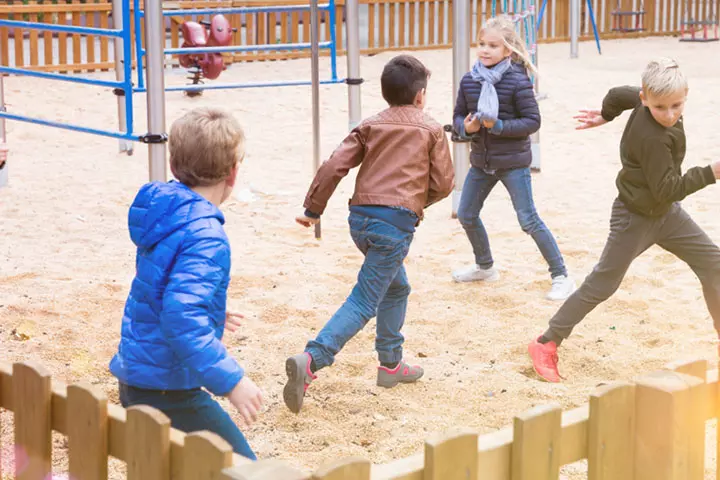
Number of players: 2 or more
You will need: Open space
How to play:
- Select the player who will be the chaser and chase others.
- You can choose by counting, drawing straws, or other methods.
- Designate a specific area to play and inform all the players about the boundaries.
- The chaser will close their eyes and start counting to a predetermined number, say 20, while others will scatter throughout the ground.
- The chaser will chase and tag the other players, while others must run and dodge to avoid being tagged.
- If the chaser catches and tags a player, they will become the new chaser, and the game continues.
- You can also add the variation ‘freeze tag,’ in which the tagged players must freeze in place until another player unfreezes them by touching them.
Make sure that the playing area is safe and free of any obstacles. You may choose players of the same age range to ensure fair play.
23. Snake in the gutter
Snake in the gutter is a fun game for the younger kids, who love running and catching. The game can be played indoors or outdoors.

Number of players: 6,8-12
You will need: Space to play
How to play:
- The objective of the game is to pass through a gutter without getting touched by the snakes.
- Have three or more kids form a gutter by standing in a line, with a wide gap between each child, facing the remaining players. These kids become the snakes.
- The remaining kids have to try and pass the gutter while the snakes try to touch them.
- If the kid gets touched by a snake, he becomes a snake and joins the others in the gutter.
This fun game can be played with primary and middle school kids.
24. Elves, wizards, and, giants
This is a unique version of Rock, Paper, and Scissors, except the kids will use their hands, legs and even entire bodies instead of just fingers.

Number of players: 4-12
You will need: Large area/space to play
How to play:
The rules for this game are similar to the rules of Rock, Paper, and Scissors.
- Giants can conquer wizards. The kids have to raise their hands above their head when they stand to pose as giants.
- Wizards can conquer elves. To be a wizard, the kids have to form a triangle with their arms over their head, replicating a wizard hat.
- Elves can conquer giants. To pose as an elf, kids have to place their hands alongside the ears, with the index finger extended just a little.
Once the rules are clear, you can start the game.
- Divide the kids into two teams, and also divide the room or play area into two zones.
- Each team will have a safe zone where the stronger team cannot attack them.
- The teams will stand at least four feet apart from each other. The teams can huddle and discuss what they want to be and on the count of three by the moderator, shout out who they are.
- If one team chooses an option stronger than the other, they can chase the weaker team and try to tag them before they reach the safe zone.
- Anyone who gets tagged becomes a part of the opposing team.
Playing this game can foster agility, teamwork, cooperation, and active listening skills in addition to promoting trust-building among the players.
25. All over
This game is similar to the beach ball or Nerf ball games, where the teams try to push all the objects towards the other team to win.

Number of players: 10-16
You will need: A lot of tennis balls, footballs, basketballs, etc., space to play
How to play:
- Divide the kids into two teams with an equal number of players.
- Divide the play zone into two halves and mark the team’s territories.
- Give the teams the same number of balls and ask them to stand in their designated zones.
- On the count of three, the players will try to roll, throw, or kick the ball to the opposition’s side.
- If a team manages to push all their balls to the other side, they shout out ‘All over’ and win.
- If there are way too many balls, you can set a timer and at the end, whichever team has fewer balls wins.
It is best to use lightweight balls for this game, to minimize the risk of injury.
26. Catch the dragon’s tail
This fun game is ideal for middle and high school kids. It can be played by adults too!
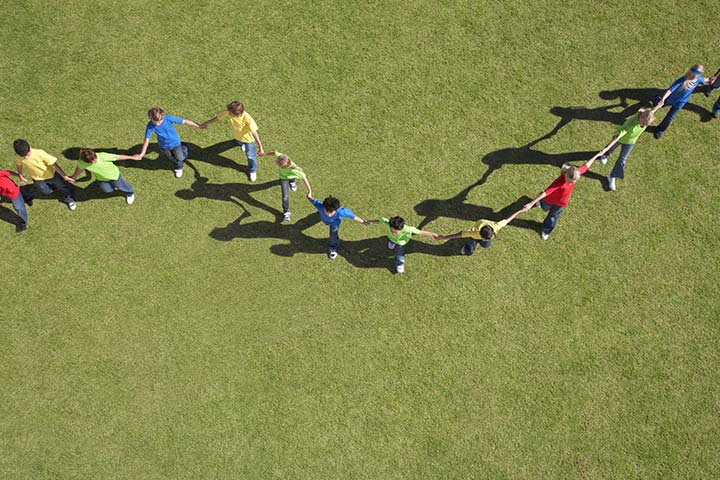
Number of players: 12-18
You will need: A large ground or space where the game can be played
How to play:
This is a simple game that requires the kids to form a long chain and not break it.
- Ask the kids to form a long human chain by holding hands.
- The person standing first is the head of the dragon and the one at the end is the tail of the dragon.
- The head should try and catch the tail, while the others in the middle should try and stop the head, without breaking the chain.
- If the head succeeds in catching the tail, the tail becomes the head, and the person at the end of the chain becomes the tail.
- And the game continues with the new head and tail.
This game helps children think about strategy and develop agility and swiftness.
27. Molecules
This game has minimal physical activity but engages the child’s listening skills and their ability to respond quickly. The game is best played in an auditorium or a playground.

Number of players: 20-30 (large groups)
You will need: Space to play
How to play:
- Ask the participants to walk freely around the room.
- The moderator then asks the kids to make “molecules of…”. The participants have to form groups or show characteristics of that object.
For instance, if the leader says:
- ‘Form molecules of six,’ the players will have to form groups of six quickly. Anyone who fails to be a part of a team is out.
- ‘Form molecules of one,’ the players have to stand on one leg and put their hands straight up, like the number one.
- ‘Molecules of a submarine,’ they have to lie down on the floor and put one leg up, like the submarine’s viewfinder.
You can create a list of objects that you want the kids to imitate. However, clear instructions must be given to the participants beforehand.
- Anyone who fails to follow instructions is out of the game.
The game can be played for as long as the kids are having fun or when just two to three kids are remaining in the field.
28. Tug of war

Number of players: 6-12 (3-6 per team)
You will need: A long, sturdy rope, a marker or flag, soft, level ground
How to Play:
- Divide children into two teams of equal strength.
- Lay the rope on the ground and place the marker at the center.
- Each team takes a position on either side of the marker, holding the rope.
- On the signal, both teams pull the rope towards their side.
- The team that pulls the marker past a predetermined point wins.
- Ensure safety by playing on soft ground and supervising closely.
29. Taboo word game

Number of players: 4-10
You will need: Taboo game cards (or homemade cards with words), timer
How to Play:
- Divide children into two teams.
- One player from the first team draws a card and tries to describe the word to their team without using the taboo words listed.
- The team has a set time (e.g., one minute) to guess the word.
- If guessed correctly, the team earns a point. If the taboo words are used, the turn ends.
- Alternate turns between teams take place.
- The team with the most points after a set number of rounds wins.
30. Duck, duck, goose
It is a fun chase game that requires open space for running and sitting.

Number of players: 5 or more
You will need: Open space
How to play:
- Select one player as the ‘picker’ while others are ‘goose.’
- Have all the players sit in a circle facing inward.
- The picker stands up and walks around the circle, while gently tapping each seated player’s head or shoulder, saying “duck” each time.
- At any point, the picker could tag any player as ‘goose’ instead of ‘duck’ and start running.
- As soon as the player is tagged as ‘goose,’ the seated player needs to stand and chase the picker before the picker runs around and reaches the goose’s spot to sit.
- If the picker sits in the goose’s spot without being tagged, the goose becomes the new picker, or else, the picker will remain the picker and the game continues.
31. Ring toss
Ring toss can be played in groups or individually. The goal is to toss all the given rings onto a target.
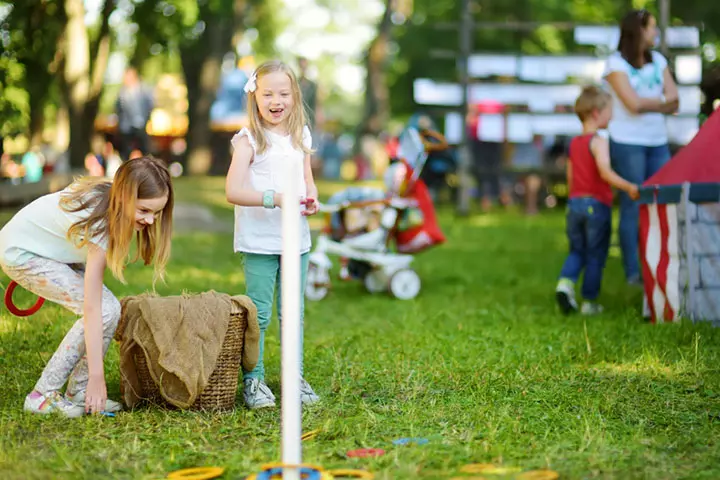
Number of players: 2 or more
You will need: Open space, rings, targets such as pegs, bottles, coins, money, biscuits, chocolates, or toys, a book and pen
How to play:
- Place the pegs or other targets at a distance from the throwing point. Spread the pegs or targets at a distance from each other.
- Select the order in which the players will take turns to play.
- Give a specified number of chances, say five, to toss the rings for each player. Assign a score for each goal. You can also assign high points depending on the distance of the targets from the starting point.
- Have the players stand behind the throwing line to toss the rings.
- Give scores to each player as per their goal.
- Once all the players have gotten their chance, add up the scores.
- The team or the player with the highest score wins the game.
32. Marbles
Marbles is an interesting and fun game in which you hit another marble from the designated area. It is suitable for children ages five or older under supervision to prevent choking or injury from the marbles.

Number of players: 2 or more
You will need: Marbles, chalk, open space
How to play:
- Give each player a set of marbles. The bigger ones are called ‘shooter’ or ‘taw’ and are used for shooting.
- Use chalk to draw circles big enough to accommodate 8-10 small marbles, spread evenly. You can make a circle of 1m in diameter.
- Mark a shooting line with a chalk a few meters away from the circle.
- Select the order in which the players will take turns to play.
- Have the player shoot the marbles with the taw or shooter from behind the shooting line.
- To shoot properly, have the player kneel and flick the shooter towards the circle.
- If the player successfully shoots the marbles out of the circle, they will keep the marbles and get another chance.
- If the player misses the circle or fails to knock any marbles out, the next player will get the chance.
- Continue the game with players taking turns. You can end one round when all the marbles are out of the circle.
- After a set number of rounds, the player with the most marbles will win the game.
33. Red light, green light
It is a fun outdoor or indoor game requiring stability and attention. The goal is to reach the finish line without being caught moving.
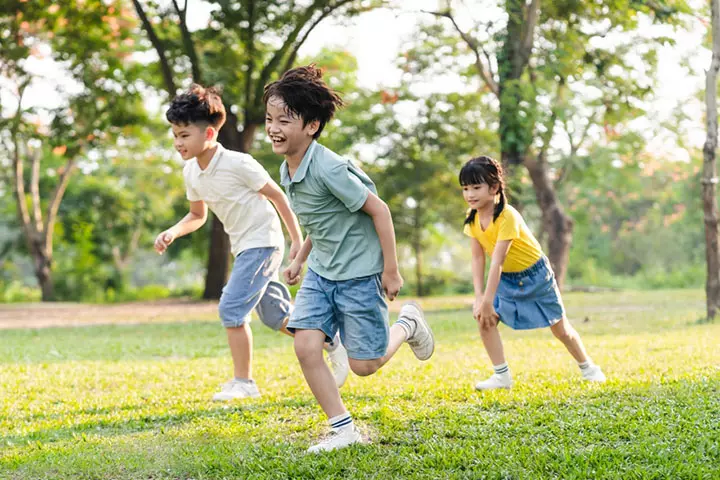
Number of players: 3 or more
You will need: Open space, chalk
How to play:
- Mark on the ground the starting and the finishing line with chalk.
- The distance between the starting line and the finish line may depend on the available space, the number of players, and their age.
- Choose a player to be the leader who will stand at the finishing line while other players will be standing at the starting line.
- The leader will say “Green light” while turning the back to the players. Meanwhile, players can start moving towards the finishing line.
- When the leader says “Red light” and turns around, all the players must freeze and stop moving.
- If the leader catches anyone moving, that player will get eliminated, and the game continues.
- The player who reaches the finish line first without being caught wins the game.
34. Blindfold
This classic game is also a chase game, making it a fun and exciting outdoor group game for kids.

Number of players: 3 or more
You will need: Scarf or bandana for blindfolding, open space
How to play:
- Choose a designated area to play in. Make sure the place is safe and free of potential obstacles.
- Choose one player to be the blindfolded chaser. Ensure that the blindfold is securely placed and has no visibility.
- When someone calls out ‘start,’ the blindfolded player will try to tag other players by listening to their movements.
- Other players must move and dodge as quietly as possible but remain within the play area’s boundaries.
- If the blindfolded player catches someone and guesses the player’s name correctly, the caught player will become the new chaser.
- If the guess is incorrect, the game will continue with the blindfolded player continuing as the chaser.
While playing, ensure that no players stay still or sit quietly in one position. Also, supervise younger children when playing to prevent injuries and falls.
35. Hide and seek
Hide and seek is a traditional childhood game that has been played for ages. It is an indoor and outdoor game for large groups of children and adults.

Number of players: 3 or more
You will need: Objects and places to hide
How to play:
- Decide on a seeker by counting out, drawing straws, or any other method.
- Set a specified area for other players to hide. This will ensure safety and fairness.
- Designate a place where the seeker will close their eyes and count out loud.
- Make sure the seeker is counting slowly and loudly, giving enough time for other players to hide.
- Once the seeker counts up to a certain number, they shout, “I am ready!” and start looking for the hiders.
- The seeker will search the specified area for hiders and tag each.
- If a hider is found, they must try to run to the designated place where the seeker was counting without getting tagged.
- If the seeker tags the hider before they reach home base, the hider is out.
- The game continues until all hiders have been found and tagged.
- The first hider found becomes the next seeker in the next round.
Make sure that the place where you’re playing is safe. You can adjust the counting and boundaries for younger children.
Frequently Asked Questions
1. Which group games for children require minimal equipment?
Classic games (such as Hide and Seek), chase games (Foxes and Hares), pair games (Shadows), and tag games (Stuck in the Mud and Duck Duck Goose) are some games your children can play without equipment.
2. How can parents ensure that group games for children are age-appropriate?
When selecting a group game for children, ensure that it suits their intellectual, cognitive, emotional, physical, and behavioral development. If a child has some mental or physical disability, you should consider it when planning outdoor games.
3. How can group games help foster collaborative problem-solving skills?
When children engage in group activities, they encounter a shared scenario that challenges them to collectively address a problem. As a result, group dynamics come into play, and they work collaboratively to generate the optimal solution. This not only fosters teamwork but also enhances group decision-making and collaborative problem-solving skills.
4. What safety precautions should we take when playing group games with children?
When playing group games with children, ensure the play area is confined and secured by a fence, no sharp or harmful objects are present, the first aid kit is handy and there is access to clean water (especially when playing outdoors).
5. What are some group games for small spaces?
Group games help children learn valuable social skills. They learn about sportsmanship, teamwork, fair play, leadership, and the importance of collaboration. These games teach children how to be a part of a team and facilitates bonding. They aid in the overall development of your child’s mind and body. It improves the child’s motor and cognitive skills. Depending on the number of participants, age group, and other factors, you can pick any game from this elaborate list.
Illustration: Best Group Games For Kids
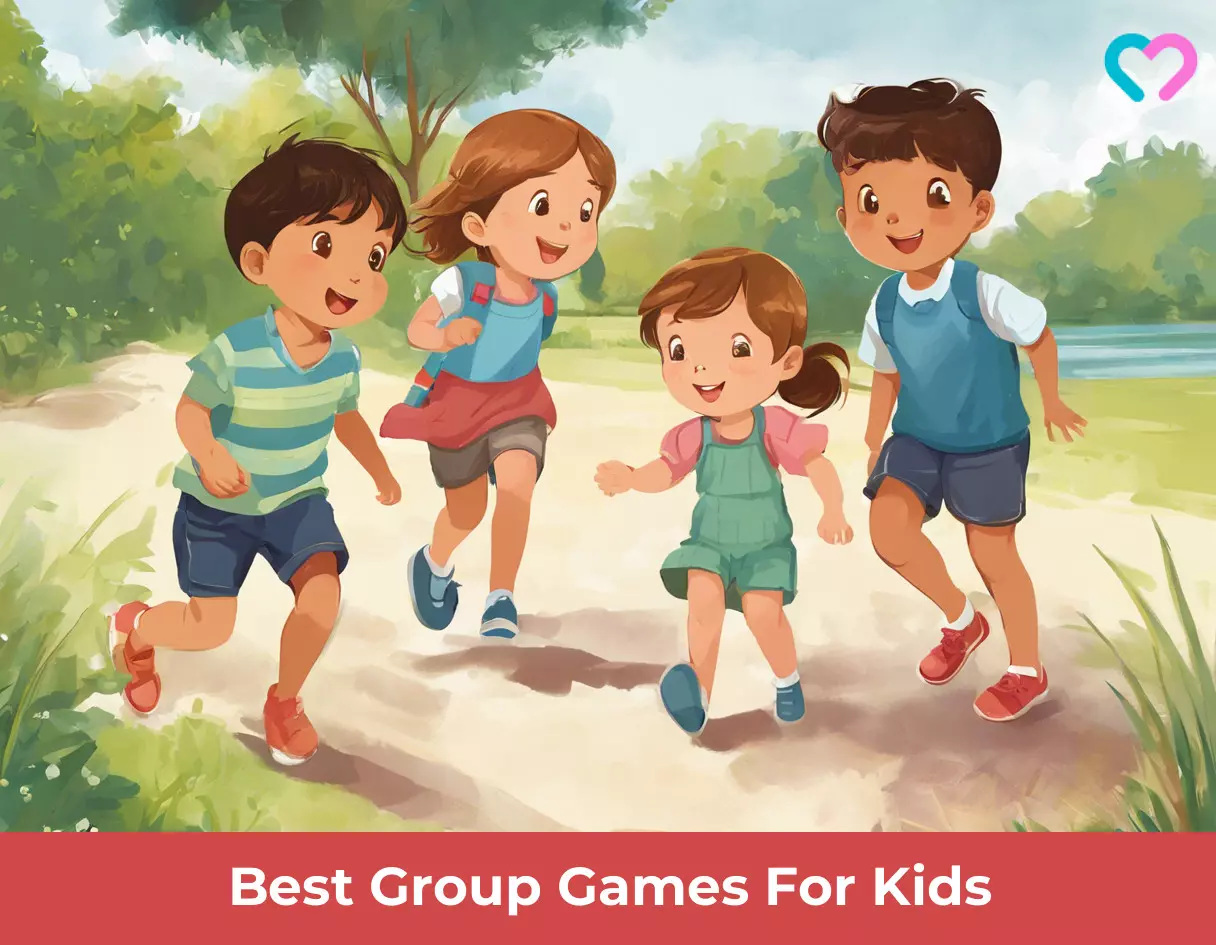
Image: Stable Diffusion/MomJunction Design Team
Gather all the kids of the neigborhood and and engage them in hours of fun and friendly competition with these 4 new group games.
Personal Experience: Source
MomJunction articles include first-hand experiences to provide you with better insights through real-life narratives. Here are the sources of personal accounts referenced in this article.
i. #99 Play “Fruit Basket”- Game #14https://www.youtube.com/watch?v=VFw8MfjRd_I
Community Experiences
Join the conversation and become a part of our nurturing community! Share your stories, experiences, and insights to connect with fellow parents.
Read full bio of JoAnn Moore
Read full bio of Harshita Makvana
Read full bio of Deepa Thomas
Read full bio of Nisha Bharatan






